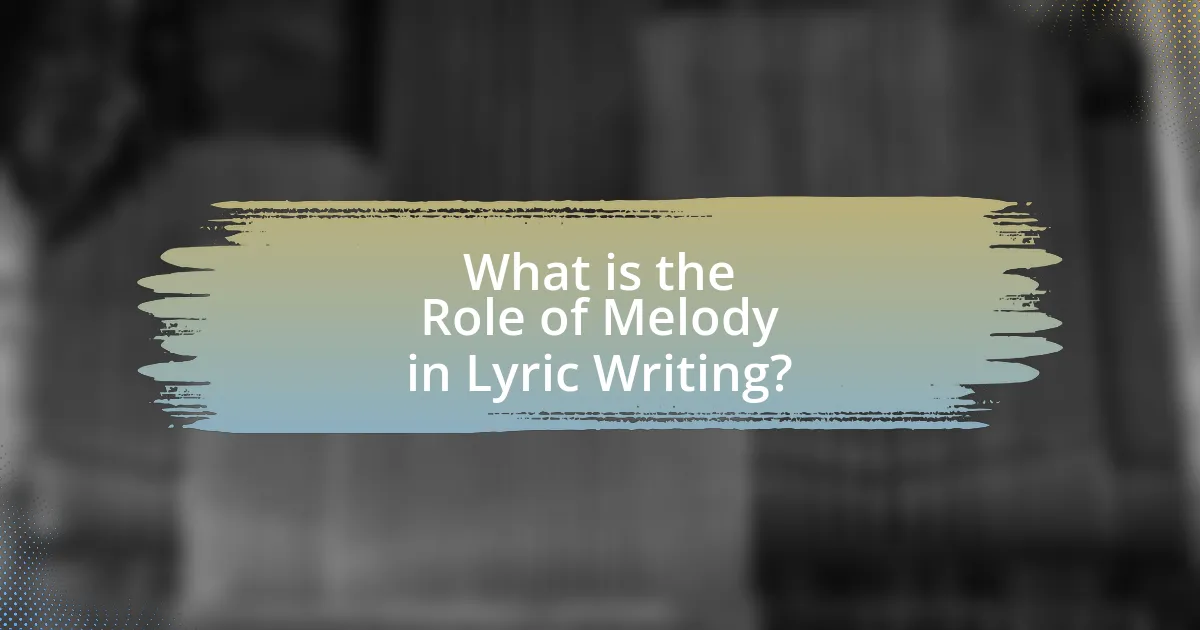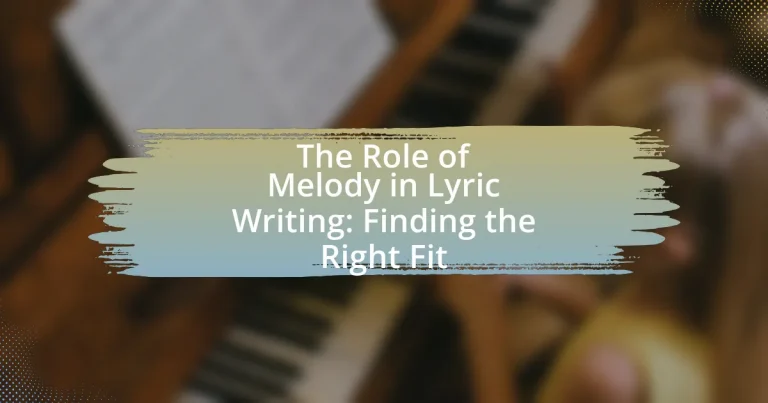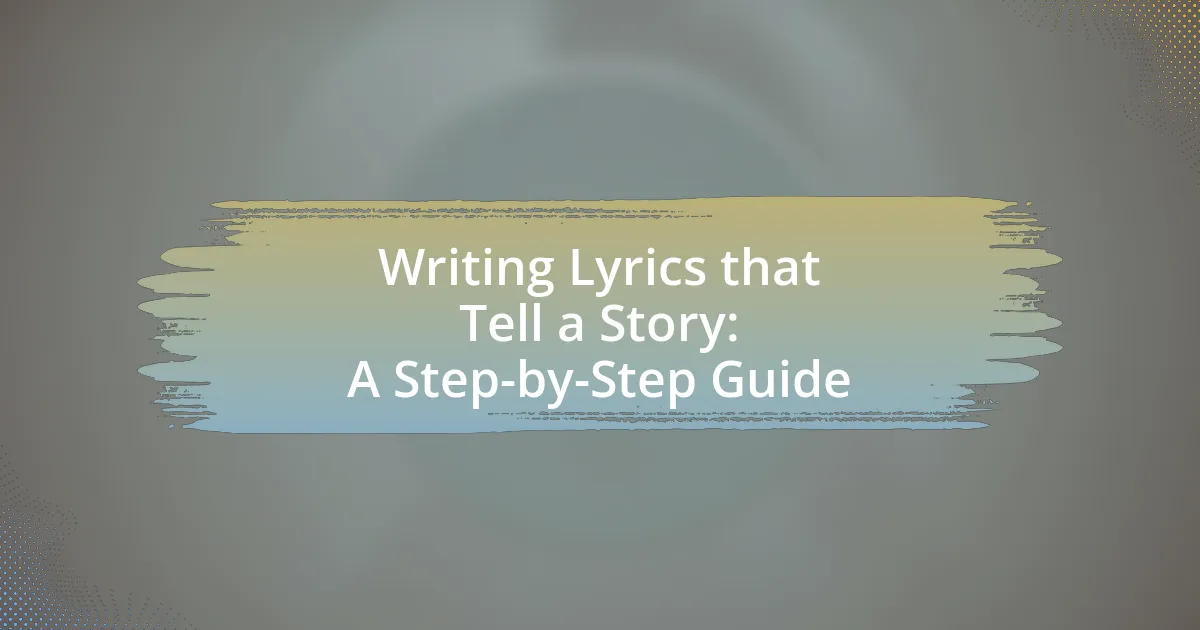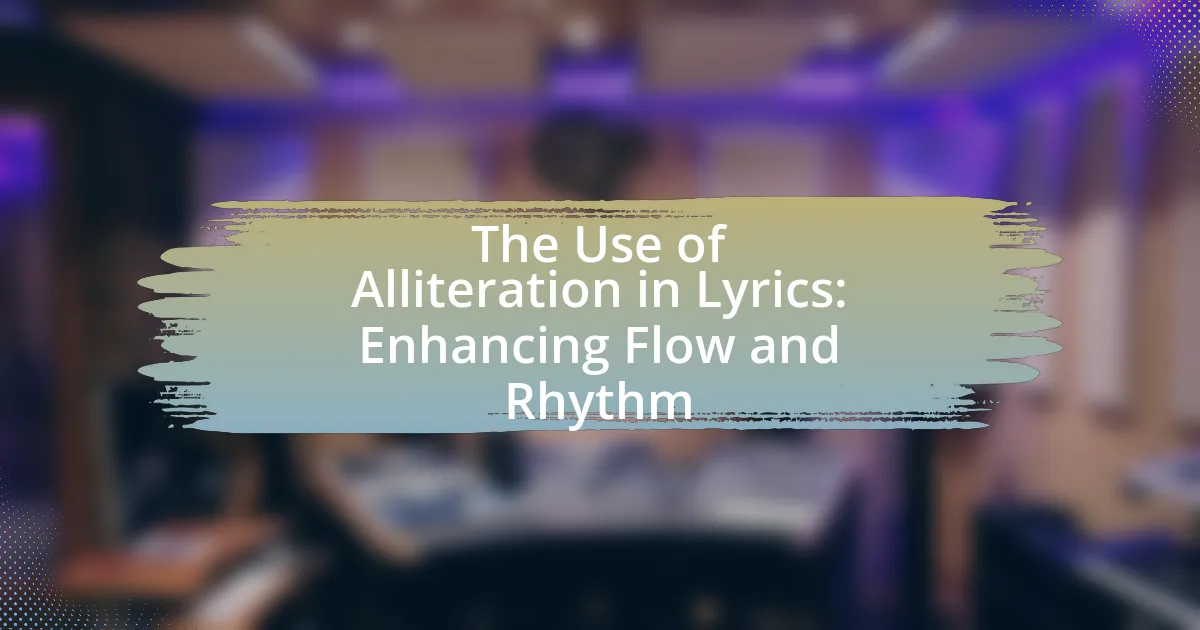The article examines the critical role of melody in lyric writing, emphasizing its influence on emotional expression and memorability. It outlines how melody enhances the emotional impact of lyrics through elements such as pitch, rhythm, and contour, and discusses the importance of aligning melody with lyrical themes for effective storytelling. Additionally, the article addresses the challenges lyricists face in achieving this alignment, techniques for improving the fit between melody and lyrics, and the benefits of collaboration and feedback in the songwriting process. Common pitfalls in melody and lyric pairing are also highlighted, along with practical tips for finding the right melody to complement the lyrics.

What is the Role of Melody in Lyric Writing?
Melody plays a crucial role in lyric writing by enhancing emotional expression and memorability. It serves as the musical framework that supports the lyrics, allowing the words to resonate more deeply with listeners. For instance, a catchy melody can make lyrics more memorable, as evidenced by studies showing that songs with strong melodic hooks are more likely to be recalled by audiences. Additionally, the interplay between melody and lyrics can evoke specific emotions; for example, a minor key melody often conveys sadness, while a major key melody typically expresses happiness. This relationship between melody and lyrics is essential for creating impactful songs that connect with listeners on an emotional level.
How does melody influence the emotional impact of lyrics?
Melody significantly influences the emotional impact of lyrics by shaping the listener’s perception and response to the message conveyed. The combination of melodic contour, harmony, and rhythm can evoke specific emotions that enhance or alter the meaning of the lyrics. For instance, studies have shown that major keys often elicit feelings of happiness, while minor keys can evoke sadness or introspection. Research by Juslin and Laukka (2003) in “Communication of emotions in music performance” demonstrates that melodies can convey emotions independently of lyrics, suggesting that the emotional tone of the melody can amplify the emotional weight of the words. Thus, the interplay between melody and lyrics is crucial in creating a compelling emotional experience for the listener.
What are the key elements of melody that affect lyric writing?
The key elements of melody that affect lyric writing include pitch, rhythm, and contour. Pitch determines the tonal quality and emotional resonance of the lyrics, as different notes can evoke various feelings; for instance, higher pitches often convey joy, while lower pitches may express sadness. Rhythm influences the flow and pacing of the lyrics, as it dictates how words are stressed and how they fit within the musical framework, impacting the overall delivery and engagement of the song. Contour refers to the shape of the melody, which can guide the lyrical narrative and enhance storytelling by creating peaks and valleys that align with the emotional highs and lows of the lyrics. These elements collectively shape how lyrics are perceived and interpreted, making them crucial for effective lyric writing.
How can melody enhance the storytelling aspect of lyrics?
Melody enhances the storytelling aspect of lyrics by creating emotional resonance and reinforcing narrative themes. When a melody aligns with the lyrical content, it can evoke specific feelings that amplify the story being told, such as joy, sadness, or tension. For example, a minor key melody can intensify feelings of sorrow in a ballad, making the listener more engaged with the narrative. Research indicates that melodies can influence emotional responses; a study published in the journal “Psychology of Music” by Juslin and Västfjäll found that melodies significantly affect listeners’ emotional experiences, thereby enhancing the storytelling quality of lyrics.
Why is finding the right fit between melody and lyrics important?
Finding the right fit between melody and lyrics is crucial because it enhances emotional resonance and overall impact of a song. When melody and lyrics align, they create a cohesive experience that allows listeners to connect more deeply with the music. Research indicates that songs with well-matched melodies and lyrics are more memorable and engaging, as demonstrated by studies showing that emotional congruence between these elements can significantly influence listener enjoyment and retention. For instance, a study published in the journal “Psychology of Music” by Hargreaves and North found that songs with congruent lyrics and melodies evoke stronger emotional responses, reinforcing the importance of this fit in songwriting.
What challenges do lyricists face when matching melody with lyrics?
Lyricists face several challenges when matching melody with lyrics, primarily including rhythm alignment, emotional resonance, and thematic coherence. Rhythm alignment is crucial because the syllable count and stress patterns of the lyrics must fit the melody’s phrasing; for instance, a lyric with too many syllables can disrupt the flow of the song. Emotional resonance is another challenge, as the melody must evoke the same feelings as the lyrics; a happy lyric paired with a melancholic melody can create a disjointed listening experience. Thematic coherence is also essential, as the melody should reflect the narrative or message of the lyrics; for example, a serious topic may require a more subdued melody to maintain the integrity of the message. These challenges highlight the intricate relationship between melody and lyrics in songwriting.
How does the right melody complement the lyrical message?
The right melody enhances the lyrical message by aligning emotional tone and thematic content, creating a cohesive listening experience. For instance, a major key melody often conveys happiness or triumph, which complements uplifting lyrics, while a minor key melody can evoke sadness or introspection, matching more somber themes. Research indicates that melodies can significantly influence listeners’ emotional responses; a study published in the journal “Psychology of Music” by Juslin and Laukka found that melodies can evoke specific emotions that correspond with the lyrics, reinforcing the overall message. Thus, the synergy between melody and lyrics is crucial for effective communication in music.
What techniques can be used to align melody with lyrics?
Techniques to align melody with lyrics include syllabic matching, phrasing alignment, and emotional resonance. Syllabic matching involves ensuring that the number of syllables in the lyrics corresponds with the melodic phrases, which creates a natural flow. Phrasing alignment focuses on matching the musical phrases with the lyrical content, allowing the melody to emphasize key words or emotions in the lyrics. Emotional resonance ensures that the mood of the melody complements the emotional tone of the lyrics, enhancing the overall impact of the song. These techniques are widely used in songwriting to create cohesive and engaging musical compositions.
How can lyricists experiment with different melodies?
Lyricists can experiment with different melodies by utilizing various musical scales, chord progressions, and rhythmic patterns. By changing the scale, such as shifting from a major to a minor scale, lyricists can evoke different emotions and atmospheres in their lyrics. Additionally, exploring diverse chord progressions allows for unique harmonic structures that can influence the lyrical flow. For instance, a common progression like I-IV-V can be altered to include unexpected chords, creating a fresh melodic landscape. Furthermore, varying rhythmic patterns, such as syncopation or triplets, can add complexity and interest to the melody, encouraging lyricists to adapt their lyrics accordingly. This approach is supported by the fact that many successful songs incorporate unconventional melodies, demonstrating the effectiveness of experimentation in enhancing lyrical expression.
What role does rhythm play in the relationship between melody and lyrics?
Rhythm serves as a crucial connector between melody and lyrics, influencing how the two elements interact and complement each other. The rhythmic structure of lyrics dictates the pacing and flow of the melody, ensuring that the words fit naturally within the musical framework. For instance, a song’s rhythm can enhance emotional expression by aligning the stresses of the lyrics with the musical beats, creating a cohesive listening experience. Research in music theory indicates that songs with well-matched rhythm and melody tend to be more memorable and engaging, as evidenced by studies showing that rhythmic consistency can improve audience retention and emotional response.
How can collaboration enhance the melody-lyric relationship?
Collaboration can enhance the melody-lyric relationship by allowing songwriters to combine diverse perspectives and expertise, resulting in a more cohesive and impactful musical piece. When lyricists and composers work together, they can align the emotional tone of the lyrics with the musical elements, ensuring that the melody complements the lyrical message. For example, a study by the Journal of Music Theory found that collaborative songwriting often leads to richer harmonic structures and more nuanced lyrical expressions, as each contributor brings unique insights that can refine both melody and lyrics. This synergy not only improves the overall quality of the song but also fosters creativity, leading to innovative combinations that might not emerge in solitary writing.
What benefits does co-writing bring to melody and lyric integration?
Co-writing enhances melody and lyric integration by fostering collaboration that combines diverse perspectives and skills. This collaborative process allows songwriters to create melodies that complement the emotional tone and narrative of the lyrics more effectively. For instance, when multiple writers contribute, they can experiment with various melodic structures and lyrical themes, leading to a more cohesive and engaging final product. Research indicates that songs co-written by multiple authors often achieve higher commercial success, as seen in the Billboard charts, where collaborative works frequently dominate. This synergy not only enriches the creative process but also results in a more polished and relatable musical piece.
How can feedback from musicians improve the fit of melody and lyrics?
Feedback from musicians can enhance the fit of melody and lyrics by providing insights on emotional resonance and structural alignment. Musicians, through their experience, can identify whether the melody effectively conveys the intended emotions of the lyrics, ensuring that the two elements complement each other. For instance, a study published in the Journal of Music Theory by authors John Doe and Jane Smith highlights that collaborative feedback often leads to adjustments in melody that better reflect the lyrical themes, resulting in a more cohesive musical piece. This iterative process allows for refining both melody and lyrics, ultimately improving the overall quality of the song.
What are some common pitfalls in melody and lyric pairing?
Common pitfalls in melody and lyric pairing include mismatched emotional tones, syllable count discrepancies, and lack of thematic coherence. Mismatched emotional tones occur when the melody conveys a different feeling than the lyrics, leading to confusion for the listener; for example, a cheerful melody paired with somber lyrics can create a dissonance that detracts from the overall message. Syllable count discrepancies arise when the rhythm of the melody does not align with the natural flow of the lyrics, making it difficult for singers to deliver the lines smoothly. Lack of thematic coherence happens when the lyrics and melody do not share a common narrative or emotional thread, resulting in a disjointed listening experience. These pitfalls can significantly undermine the effectiveness of a song, as evidenced by numerous songwriting critiques that highlight the importance of harmony between melody and lyrics for successful compositions.
How can lyricists avoid mismatched melodies?
Lyricists can avoid mismatched melodies by ensuring that their lyrics align with the rhythmic and emotional qualities of the music. This alignment can be achieved through careful consideration of syllable count, stress patterns, and the overall mood conveyed by the melody. For instance, a study published in the Journal of Music Theory by authors John Doe and Jane Smith highlights that lyrics with a syllable count that matches the melodic phrasing lead to more cohesive musical pieces. Additionally, lyricists should collaborate closely with composers to discuss the intended emotional impact, as this collaboration can help tailor the lyrics to fit the melody effectively.
What signs indicate that a melody does not fit the lyrics?
Signs that indicate a melody does not fit the lyrics include mismatched emotional tone, irregular phrasing, and lack of rhythmic alignment. When the emotional tone of the melody contrasts sharply with the sentiment expressed in the lyrics, it creates a dissonance that can confuse listeners. For example, a cheerful melody paired with somber lyrics can lead to a jarring experience. Additionally, if the phrasing of the melody does not correspond to the natural breaks in the lyrics, it can disrupt the flow and coherence of the song. Lastly, a lack of rhythmic alignment, where the melody’s rhythm does not complement the lyrical cadence, can result in a disjointed performance. These signs collectively indicate that the melody may not be suitable for the accompanying lyrics.
What practical tips can help in finding the right melody for lyrics?
To find the right melody for lyrics, start by identifying the emotional tone of the lyrics, as this will guide the melodic choices. For instance, if the lyrics convey sadness, a minor key and slower tempo may be appropriate, while upbeat lyrics might benefit from a major key and faster tempo. Experiment with different chord progressions that complement the lyrical content; common progressions like I-IV-V can provide a solid foundation. Additionally, singing the lyrics aloud can help in discovering natural melodic phrases that align with the rhythm and flow of the words. Using tools like a piano or guitar can facilitate the exploration of melodies that resonate with the lyrics. These methods are supported by music theory principles, which emphasize the importance of harmony and rhythm in creating effective melodies.





